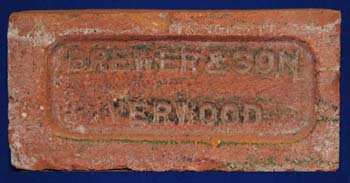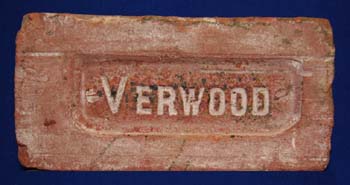|
Verwood
Brick & Tile Making. |
|
Note that this article was
originally written in 1968 by Mrs. P Reeks.
|
The
brickworks began operating in Verwood in the
1840s. One at Ebblake, on the Hampshire-Dorset
border, produced white and red bricks and drain pipes from
clay dug on the site. Apparently the white
bricks were used decoratively in house building.
These can still be seen in many houses in the village today.
This brickyard closed about 1908 to 1909 as apparently the
seam of clay had been completely dug.
 The Blackhill brickyard was situated on a seam
of London Clay. Mr. E. Batten who used to work in the
brickyard, said that the work involved which was strenuous,
to say the least. The Blackhill brickyard was situated on a seam
of London Clay. Mr. E. Batten who used to work in the
brickyard, said that the work involved which was strenuous,
to say the least.
The
clay was dug from the pits and mixed with loam or sand in an
enormous pug mill. This mixture was then forced
into a chamber which squeezed the clay out in a long
slab. A piece of mechanism was worked by foot to
bring eleven cheese-wires down, which cut ten bricks at a
time. With a piece of metal the bricks were
pulled on to a board on a table, and from there three boards
of sixty bricks were placed on a brick-barrow.
This was longer than a garden wheel-barrow and was made of
wood with a cast iron wheel. I was told that in wet weather
when the ground was saturated, that a barrow load of bricks
took a great deal of strength to move. The
bricks were wheeled outside to be placed in the
"hacks" to dry. The "hacks"
consisted of clots of earth as a base, weather boarding at
the sides and a wooden or corrugated iron "cap" to
protect the bricks from the weather.
After
being dried the bricks were fired in a German type kiln,
which was fired from the top. The kiln had
twelve chambers and three firing holes and was a continuous
kiln, which meant that the chambers were fired in
rotation. Each chamber of bricks was at one of
three stages of the process i.e. either (1) drying to
re-move the steam (2) firing or (3) cooling. The
German kiln had flues through each chamber which were
brought into use by the opening of the dampers to raise the
heat and cooled down by the dampers being closed.
 Across the Ringwood road from Blackhill on the
land which is now the Strathmore Housing Estate, I am told
there was another clay-pit. Drain pipes were
made there and wheeled across to the Blackhill kiln for
firing. Across the Ringwood road from Blackhill on the
land which is now the Strathmore Housing Estate, I am told
there was another clay-pit. Drain pipes were
made there and wheeled across to the Blackhill kiln for
firing.
There was also a further brickyard near the station
where clay was dug on the site and worked on the same
principles as the Blackhill works (which incidentally closed
down in 1930) and had a German type kiln.
For information about the now demolished Gotham Brick & Tile Company
Works in Verwood please select the link.
Copyright © P Reeks.
|